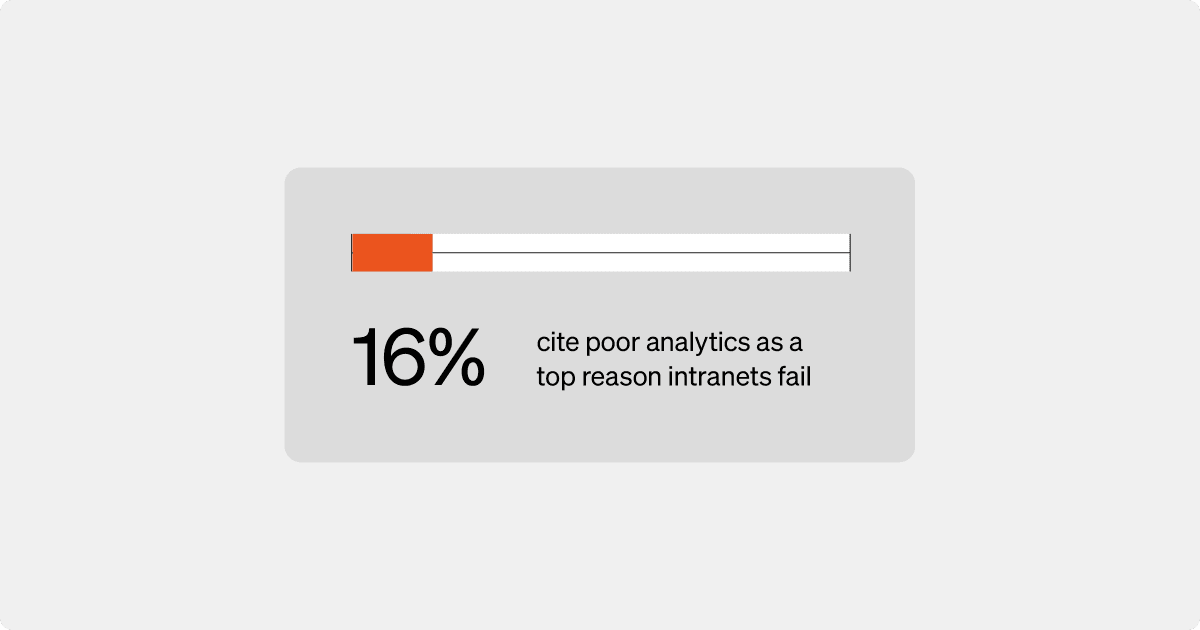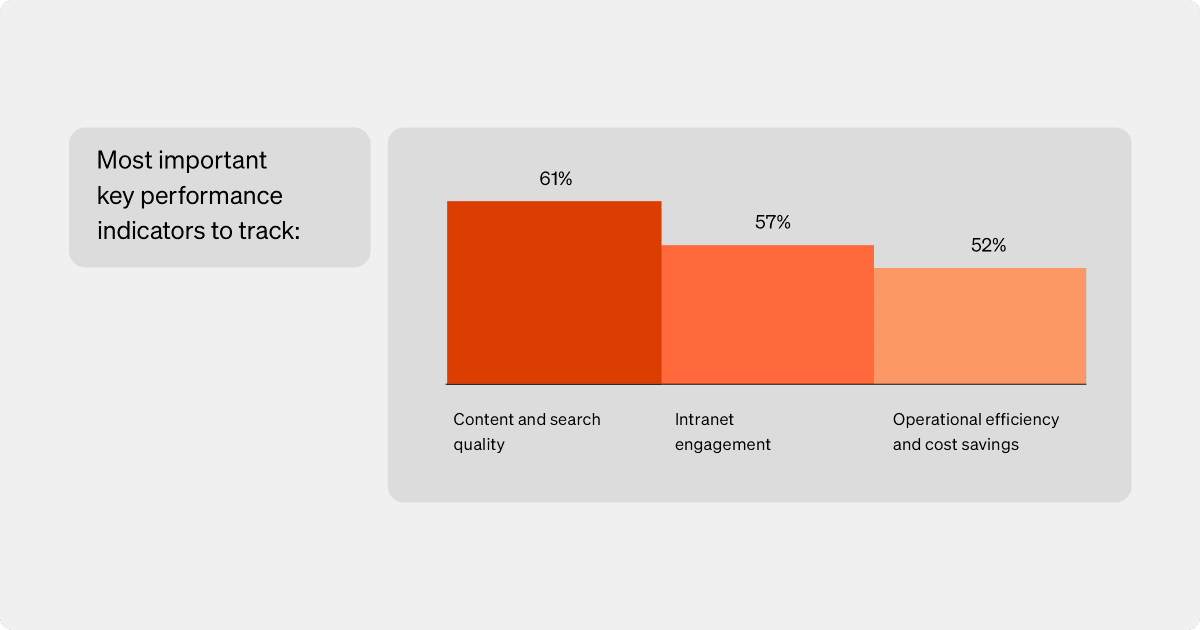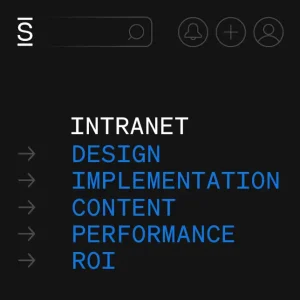This is part seven of our “Why intranets fail” series. Read parts one, two, three, four, five and six.
Intranet analytics aren’t just numbers — they’re the vital signs of your platform’s health. A thriving intranet keeps employees connected, informed and engaged, making it central to the digital workplace. But getting it there requires more than simply setting up an intranet and hoping employees use it. For intranet program managers, the challenge lies in understanding what’s working, what’s not, and how to make improvements that truly matter to employees.
Advanced analytics allow managers to go beyond assumptions, revealing clear patterns in how employees engage with content, search for information, and navigate the platform. Without these insights, intranets can quickly become stale or misaligned with users’ needs.
In a recent Simpplr survey of senior intranet program leaders, more than 15% said insufficient analytics contributed to the failure of their intranets.

With an intranet solution that includes robust analytics, however, intranet managers can make informed, data-driven decisions that drive strategic improvements. From optimizing the user interface to refining content quality and boosting engagement levels, analytics are key to keeping the intranet relevant and valuable in a fast-moving workplace.

- 1 Key performance indicators for intranet success
- 2 Improving intranet engagement with analytics
- 3 Measuring intranet adoption rates and engagement
- 4 Intranet analytics for performance improvement
- 5 Steps to enhance intranet analytics for performance improvement
- 6 Benefits of AI-powered intranet analytics
- 7 Building a business case with data
- 8 Data-driven strategies for intranet improvement
Key performance indicators for intranet success
Sophisticated analytics empower intranet managers to measure key performance indicators (KPIs) for intranet success accurately and regularly. KPIs provide a clear picture of how effectively an intranet supports employee engagement, productivity and overall workplace efficiency.
Going beyond basic clicks and page views, sophisticated intranet analytics offer insights into deeper metrics like content relevance, engagement levels and user satisfaction. For intranet managers, tracking these metrics is essential to ensure the platform meets evolving employee needs.
High-performing intranets rely on advanced analytics to stay relevant and effective, adapting to support the changing dynamics of the workplace.
With analytics focused on performance improvement, intranet managers can make strategic updates that keep the platform valuable and responsive — a single source of truth employees can depend on every day.
These metrics provide actionable insights for a healthier intranet:
- Intranet adoption rates measure how frequently employees use the platform across departments or roles, indicating overall platform success.
- Content engagement reveals which content resonates most with employees and highlights areas where updates may be beneficial.
- Search effectiveness tracks how often employees find the information they need or encounter roadblocks, revealing potential gaps in navigation or content.
- Content and search quality indicate how well the intranet provides relevant and accurate information, supporting employees in efficiently locating the resources they need.
- Intranet engagement assesses the frequency and depth of employee interactions with the platform, providing a clear picture of its value as a collaborative tool.
- Operational efficiency and cost savings show the impact of the intranet on reducing redundant work and saving time, which directly supports overall productivity goals.
- User satisfaction scores, often gathered through surveys, offer insights into what employees value and where improvements might be needed.

Related: 25 best employee engagement survey questions
Improving intranet engagement with analytics
For an intranet to be an essential tool, it needs to stay relevant and useful as employees’ needs evolve. Analytics provide the insights that keep intranet managers in tune with what employees find valuable, what’s falling short, and how to adjust.
By monitoring specific KPIs, managers can ensure the intranet remains a central, engaging resource for employees.
Here’s a straightforward approach to guiding your process:
Leverage AI-powered analytics
With AI-powered analytics capabilities, you can uncover insights beyond basic metrics, identifying patterns that indicate what’s working and where adjustments are needed. AI also reduces manual data analysis, allowing managers to monitor engagement in real time.
Include intranet metrics in employee surveys
Adding questions about intranet usability, content quality and engagement in regular employee surveys provides qualitative data that supplements your KPIs.
Evaluate content quality regularly
By tracking engagement levels, content freshness and relevance, you help ensure that employees can trust the intranet as a reliable resource.
Share metrics across the organization
When both executives and employees understand intranet goals and performance, they’re more likely to engage with and support improvement efforts.
Measuring intranet adoption rates and engagement
Intranet adoption rates provide insight into platform success by showing how often employees rely on it for information and collaboration.
This KPI is particularly valuable for identifying departments or user groups with low engagement, which could indicate usability issues or gaps in relevant content.
Improving intranet engagement with analytics starts with measuring who uses the intranet and how they interact with its features. Analytics that track engagement and adoption provide insightful data for content strategy adjustments, allowing you to meet employees where they are. For example, if certain types of content see low engagement, it could signal a need for new formats, such as video summaries or interactive infographics.
Related: 17 intranet best practices to raise employee engagement
Intranet analytics for performance improvement
Imagine an intranet manager who notices a dip in engagement rates, especially among remote employees. With detailed analytics, they can identify trends like low adoption of specific tools or content types.
By addressing these issues — such as through targeted employee communications campaigns or content updates — the manager can boost adoption rates, making the intranet a valuable resource once again. When analytics inform every update, redesign and content addition, the intranet becomes a dynamic platform that grows alongside the organization’s needs.
Related: How to use AI to personalize and target communications
Steps to enhance intranet analytics for performance improvement
Effective intranet analytics go beyond tracking clicks — they’re the foundation of a data-driven strategy that can elevate employee experience and drive meaningful improvements across your digital workplace. But unlocking the true value of analytics requires a structured approach that makes data accessible, actionable and aligned with your company’s goals.
By taking a few intentional steps, you can ensure that your intranet’s analytics become a powerful tool for enhancing performance and supporting decision-making at every level. To make sure your analytics are truly working for your organization, consider these practical strategies:
Benchmark against industry standards
An intranet packaged solution like Simpplr gives you the ability to benchmark results against industry best practices. By comparing your intranet to top performers in your field, you can better understand where your intranet is effective and identify potential areas for improvement.
Customize reporting dashboards
Personalized dashboards let stakeholders quickly access the metrics that matter most, making it easier to track and respond to performance trends. Tailoring these dashboards for different teams also keeps everyone aligned on priorities, from executive leadership to content managers.
Automate alerts for performance changes
Setting up automated alerts for shifts in key metrics, like engagement or usability, ensures that you can respond proactively to trends as they emerge. Real-time alerts save time and allow for quick interventions to keep the intranet running smoothly.
Integrate analytics into your digital workplace strategy
Analytics should reflect more than intranet performance — they should support your broader digital workplace goals. By aligning intranet KPIs with organizational objectives, you can better demonstrate the intranet’s impact on companywide initiatives and foster greater buy-in across teams.
Benefits of AI-powered intranet analytics
Intranet analytics offer far more than just visibility into platform usage — they empower organizations to refine, optimize and justify their intranet’s role in the digital workplace. Tracking and measuring key metrics is essential for building a more effective and user-friendly intranet, creating a platform that employees genuinely rely on.
Only 33% of large organizations track intranet adoption rates or gather feedback from frontline managers.
AI-powered analytics deliver quantifiable insights that showcase measurable improvements in productivity and engagement. When an intranet includes AI-powered analytics, it transforms data into actionable insights that can drive substantial improvements:
- Pattern detection for smarter engagement: AI uncovers user behavior patterns that reveal which content resonates most, helping intranet managers refine offerings and increase relevance.
- Personalized experiences: By monitoring individual engagement patterns, AI recommends relevant content based on user activity, creating a tailored experience that boosts usage.
- Sentiment analysis for satisfaction insights: AI gauges employee sentiment by analyzing interaction scores, offering real-time feedback on engagement levels to guide platform improvements.
- Proactive content planning: With historical data, AI predicts which content will be most valuable at specific times, allowing intranet managers to anticipate needs and keep resources relevant.
- Enhanced search effectiveness: AI-powered analytics reveal patterns in search terms and outcomes, highlighting gaps where information might be missing so managers can prioritize content that aligns with employee needs.
- Real-time insights for agile management: With real-time updates, AI allows intranet managers to respond quickly to performance shifts, adjusting strategies as needed for optimal engagement.
When analytics are built into the platform, intranet managers gain insights that drive meaningful improvements across the organization. By integrating intranet analytics for performance improvement, organizations can ensure their intranet remains a valuable, evolving tool that actively enhances employee experience and organizational goals.
Building a business case with data
Intranet data not only helps improve the user experience but also supports long-term investment. Organizations often overlook the value of internal platforms when competing for budget, but with robust analytics, you can present a data-driven case for your intranet’s impact on productivity, engagement and the employee experience.
Tracking and measuring intranet KPIs can help you build a compelling business case for continued investment in this technology.
When decision-makers see direct benefits — like faster content discovery, higher engagement rates, and improved employee satisfaction — they’re more likely to support further investments.
Related: ROI of IC: 4 steps to build a business case for better tech
Data-driven strategies for intranet improvement
A data-driven approach to intranet management offers countless benefits, from improved engagement to building a case for ongoing investment. With robust analytics in place, you can easily identify where your intranet excels and where adjustments are necessary. For organizations aiming to use their intranet as a tool for boosting productivity, maintaining an engaged workforce, and fostering collaboration, robust analytics are essential.
If your current intranet analytics aren’t providing these insights, it may be time to explore more advanced options. Simpplr’s AI-powered employee experience platform provides the analytics tools you need to make data-backed improvements that drive engagement, efficiency and a better overall experience for your team.
Ready to see the benefits of AI-powered intranet analytics? Request a demo today and discover how Simpplr can transform your intranet into a valuable digital workspace for employees.















